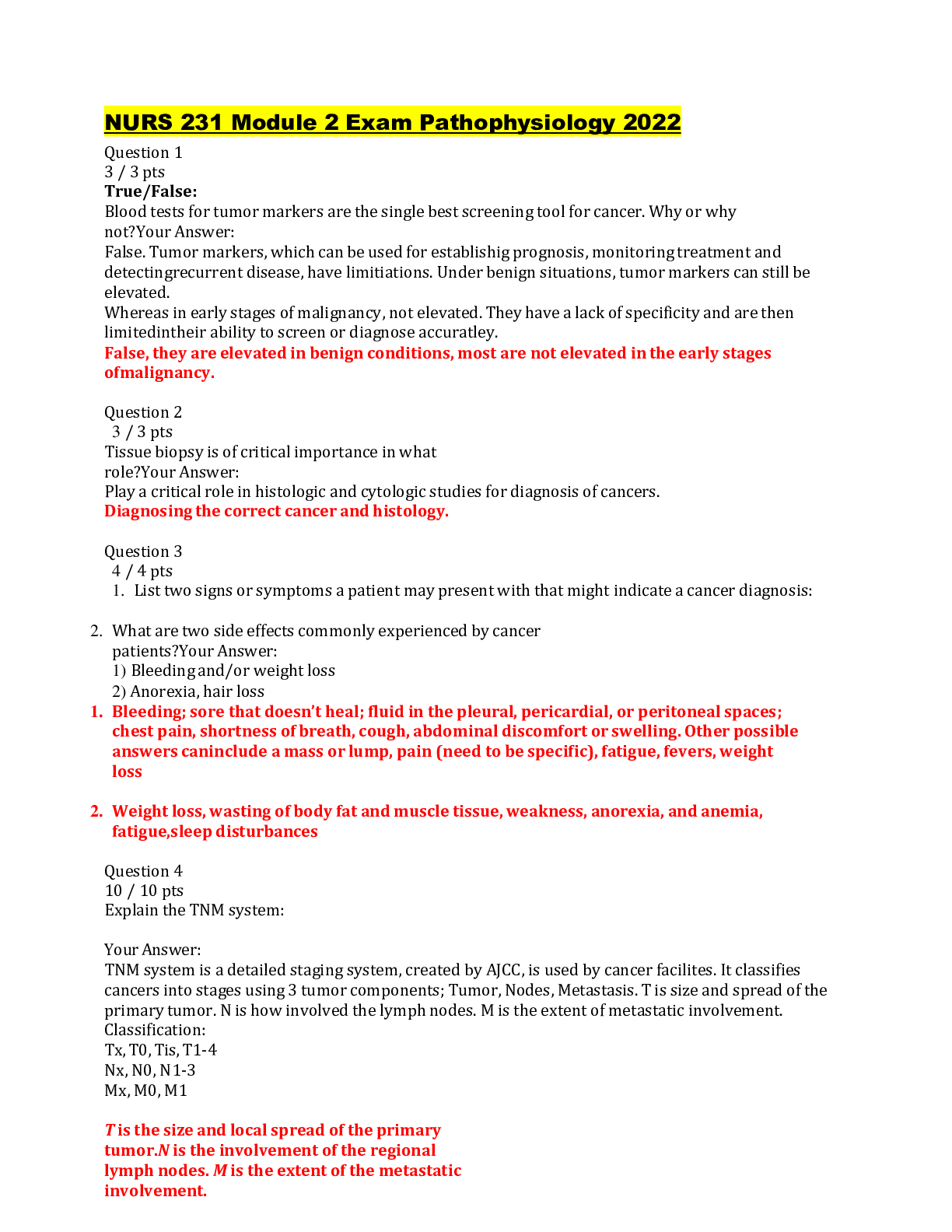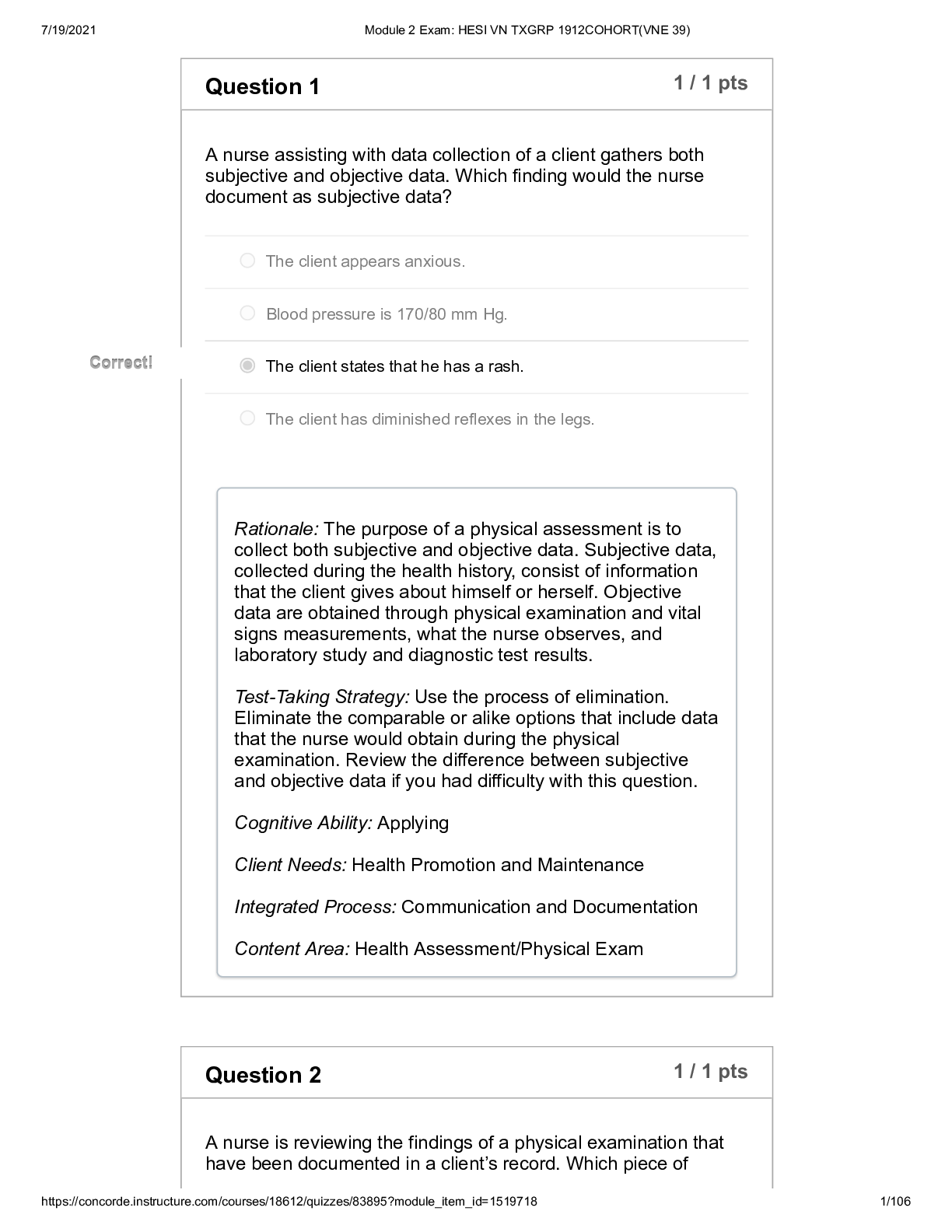Military Studies > EXAM > ACQ 202 Module 2 Exam Test Bank, answered (All)
ACQ 202 Module 2 Exam Test Bank, answered
Document Content and Description Below
ACQ 202 Module 2 Exam Test Bank, answered-Part I (contains 18 questions) Here is your test result.The dots represent the choices you have made. The highlighted questions are the questions you have mis... sed. Remediation Accessed shows whether you accessed those links.'N' represents links not visited and ' Y' represents visited links. 1.) As part of the DoD-recommended Test and Evaluation Master Plan (TEMP) format, which of the following documents is considered to be one of the four parts of the TEMP that serve as a starting point for organizing a successful T&E program? [21a. Recognize how the Test and Evaluation Master Plan (TEMP) generation, staffing and approval process integrates all functional disciplines throughout the acquisition life cycle.] [Remediation Accessed: Y] Acquisition Strategy Program Management Schedule Logistics Funding Resource Summary Test and Evaluation Strategy 2.) Which one of the following organizations would conduct testing on the flight controls of a fighter aircraft to ensure it will meet the critical technical parameters (CTPs) derived from the Capability Development Document (CDD)? [29b. Identify the key T&E support organizations within DoD.] [Remediation Accessed: N] Joint Interoperability Test Command (JITC) Defense Contract Management Agency (DCMA) Air Force Operational Test and Evaluation Center (AFOTEC) Air Force Materiel Command (AFMC) F 3.) Which one of the following test and evaluation (T&E) products is required at Milestone C? Early Operational Assessment (EOA)Live Fire Test and Evaluation (LFT&E) Report DOT&E Report on Initial Operational Test and Evaluation (IOT&E) Operational Assessment (OA) Results 4.) The operational effectiveness and operational suitability questions that must be addressed during Operational Test and Evaluation (OT&E) to assess the system's capability to perform its mission are called ___________. Critical Operational Issues (COI) Critical Technical Parameters (CTP) Measures of Performance (MOP) Key Performance Parameters (KPP) 5.) How does a program management office show the sequence and interrelationship of all the business and technical activities required to accomplish the acquisition? [3a(3). Identify the information required for a decision review and recognize the significance of the Acquisition Program Baseline (APB), Key Performance Parameters (KPPs), and Acquisition Strategy.] [Remediation Accessed: N] Acquisition Strategy - Program Structure Chart Integrated Systems Engineering/Business Management Plan Risk Management Plan Integrated Product and Process Development (IPPD) Plan 6.) What is the preferred method of controlling environmentally hazardous materials during manufacturing, operations, and disposal? Disposal is the preferred method because of new technologies and improved landfill processes.Recycling is preferred over source reduction because reuse of hazardous substances costs less than substituting alternate processes. Source reduction or elimination is the most highly preferred control strategy. Treatment of hazardous wastes is preferred over recycling because of lower manufacturing costs. 7.) One of the primary disadvantages of international cooperative development includes Schedule improvements Increased interoperability Increased documentation Technology enhancements 8.) Monitoring the performance of risk-handling actions is involved in which step of the risk management model? Risk identification Risk monitoring Risk mitigation Risk analysis 9.) The four common risk mitigation strategies are: Researching, Adopting, Adapting, and Constraining Avoiding, Controlling, Transferring, and Assuming Handling, Tracking, Incurring, and Reacting Accepting, Researching, Allocating, and Delimiting10.) Transitioning to Integrated Product and Process Development (IPPD) will involve application of certain key tenets, such as customer focus, concurrent development, and: Event-driven scheduling Supervisory leadership Reliance on independent organizations Risk avoidance 11.) Barriers to successful implementation of Integrated Product and Process Development (IPPD) include the following (Select all that apply): Contractor uses IPPD / DoD does not Need for significant cultural change Poorly run meetings or reviews Open discussions with no secrets Empowered, qualified team members 12.) By implementing Integrated Product and Process Development (IPPD), gains realized by the early integration of business, contracting, manufacturing, testing, training, and support considerations in the design process can result in ___________________. complicated detail design reviews fewer costly changes made later in the process increased logistics footprint unnecessary schedule delays 13.) Responsibility for reviewing and analyzing the results of operational test and evaluation (OT&E) conducted for each major DoD acquisition program belongs to? CongressDeputy Assistant Secretary of Defense, Developmental Test and Evaluation (DASD(DT&E)) Assistant Secretary of Defense for Research and Engineering (ASD(R&E)) Director, Operational Test and Evaluation (DOT&E) 14.) Regarding test and evaluation (T&E) issues that may affect a program’s acquisition strategy, the program office can use ______________ to aid in understanding the implications of any necessary tradeoffs among testing constraints. Early Operational Assessments Modeling and Simulation Design of Experiments (DOE) Simulation-Based Acquisitions 15.) The first key step of the Product Support Strategy Process Model includes which of the following? Establishing the Product Support Management IPT, consisting of Government and private-sector functional experts and appropriate stakeholders Understanding Warfighter requirements in terms of performance Creating a Business Case Analysis Designating Product Support Integrator(s) 16.) At which point in the life cycle does the Life Cycle Sustainment Plan (LCSP) focus on development of sustainment metrics to influence design, the product support strategy, and on actions that can be taken prior to the next milestone to reduce future operating and support costs? IOC (O&S Phase) Milestone B (EMD Phase)FRP (P&D Phase) Milestone A (TMRR Phase) 17.) Defense policy requires designated systems to be certified as interoperable. In part, testing to ensure interoperability is conducted to determine if the system is: Consistent with commercial standards and best industry practices. Fully compatible with potential threat force systems, units, and doctrine. Configured in such a manner that the user is able to operate the system without any specialized training. Able to provide and receive services from other systems. 18.) What documentation must be completed prior to a milestone review for a program that will significantly affect the quality of the environment? A Categorical Exclusion (CATEX) A Request for Waiver An Environmental Assessment (EA) An Environmental Impact Statement (EIS) Module 2 Exam, Part I (contains 3 questions) Here is your test result.The dots represent the choices you have made. The highlighted questions are the questions you have missed. Remediation Accessed shows whether you accessed those links.'N' represents links not visited and 'Y' represents visited links. 1.) The Test and Evaluation Master Plan (TEMP) links together, and must be consistent with, which of the following related program documents (Select all that apply)? Acquisition Program Baseline (APB)Initial Capabilities Document (ICD) Systems Threat Assessment (STA) Systems Engineering Management Plan (SEMP) 2.) Who would certify the interoperability performance of a command and control system used by both the Army and the Navy? Joint Requirements Oversight Council (JROC) Joint Staff Army Test and Evaluation Command (ATEC) and Navy Operational Test and Evaluation Activity (OPTEVFOR) Joint Interoperability Test Command (JITC) 3.) Threshold values, establishing (minimum) parameters for a system, and objective values, establishing desired parameters for a system, can be found in the: Acquisition Program Baseline Initial Capabilities Document Integrated Systems Engineering/Business Management Plan Acquisition StrategyModule 2 Exam, Part I Here is your test result.The dots represent the choices you have made. The highlighted questions are the questions you have missed. Remediation Accessed shows whether you accessed those links.'N' represents links not visited and 'Y' represents visited links. Back to Status page contains 18 Questions 1) The Test and Evaluation Master Plan (TEMP) is mandated by DoD policy and must be updated periodically to ensure that it stays current as the program evolves through the life cycle. [21a. Recognize how the Test and Evaluation Master Plan (TEMP) generation, staffing and approval process integrates all functional disciplines throughout the acquisition life cycle.] True False 2) Which one of the following organizations would evaluate measures of effectiveness (MOEs) to determine how well a munitions system can perform its mission? [29b. Identify the key T&E support organizations within DoD.] Marine Corps Operational Test and Evaluation Activity (MCOTEA) Marine Corps Systems Command (MARCORSYSCOM)Defense Contract Management Agency (DCMA) Joint Interoperability Test Command (JITC) 3) If the program is on the DOT&E Oversight List, which one of the following test and evaluation (T&E) products is required before the Full Rate Production Decision Review? [29c (2). Identify the primary Test and Evaluation (T&E) products required at each acquisition milestone.] [Remediation Accessed :N] DOT&E Report on Initial Operational Test and Evaluation (IOT&E) Live Fire T&E Waiver LRIP Article Quantities Approval Early Operational Assessment 4) The operational effectiveness and operational suitability questions that must be addressed during Operational Test and Evaluation (OT&E) to assess the system's capability to perform its mission are called ___________. [29c. Identify the primary Test and Evaluation (T&E) products required at each acquisition milestone.] Critical Operational Issues (COI) Critical Technical Parameters (CTP) Measures of Performance (MOP) Key Performance Parameters (KPP) 5) Threshold values, establishing (minimum) parameters for a system, and objective values, establishing desired parameters for a system, can be found in the: [3a(3). Identify the information required for a decision review and recognize the significance of the Acquisition Program Baseline (APB), Key Performance Parameters (KPPs), and Acquisition Strategy.] Acquisition Program Baseline Acquisition Strategy Integrated Systems Engineering/Business Management Plan Initial Capabilities Document6) Executive Orders 13423 & 13514, sometimes referred to as “Greening the Government": [3b. Identify key federal and DoD policies governing environmental, safety, and health issues associated with defense systems acquisition.] Directs all Federal Agencies to establish plans to improve energy efficiency, reduce greenhouse gas emissions, conserve and protect water resources and reduce or eliminate toxic or hazardous materials. States that Major Program Managers must take and pass formal training in environmental protection. Applies only to ACAT I and ACAT II programs. Exempts less-than-ACAT I programs from compliance with National Environmental Policy Act (NEPA) procedures if they have an approved Environmental Impact Statement. 7) DoD policy is to consider international cooperative development only after U.S.-only solutions have been shown to be impractical. [3d. Identify the advantages and disadvantages of international armaments cooperative development in an acquisition strategy.] True False 8) The risk management model includes risk planning, risk identification, ___________, risk handling, and risk monitoring. [4d. Identify the five activities of the risk management process.] Risk analysis Risk avoidance Risk handling Risk control 9) Identification of the possible consequences in terms of performance, schedule, and cost occurs in which step of the risk management process? [4e. Use the risk management process to identify the major areas/sources of risk in an acquisition program strategy.] Risk analysisRisk tracking Risk mitigation Risk monitoring 10) Transitioning to Integrated Product and Process Development (IPPD) will involve application of certain key tenets, such as customer focus, concurrent development, and: [5a. Relate the key tenets of Integrated Produce and Process Development (IPPD) to planning and executing an acquisition program.] Event-driven scheduling Supervisory leadership Reliance on independent organizations Risk avoidance 11) Barriers to successful implementation of Integrated Product and Process Development (IPPD) include the following (Select all that apply): [Identify the barriers to successful Integrated Product Team (IPT) implementation.] Need for significant cultural change Empowered, qualified team members Contractor uses IPPD / DoD does not Open discussions with no secrets Poorly run meetings or reviews 12) By implementing Integrated Product and Process Development (IPPD), gains realized by the early integration of business, contracting, manufacturing, testing, training, and support considerations in the design process can result in ___________________. [Identify the key acquisition best practices related to IPPD and IPTs, including commercial practices that impact the relationship between Government and industry.] fewer costly changes made later in the process increased logistics footprintunnecessary schedule delays complicated detail design reviews 13) A TEMP (either initial or updated, as appropriate) must be provided for consideration and approval before each milestone review, starting with Milestone B. [Identify the key Operational Test & Evaluation (OT&E) activities that must be coordinated with the Director, Operational Test & Evaluation (DOT&E) staff and the Operational Test Agencies (OTAs).] False True 14) Design of Experiments (DOE) can have a positive impact on test and evaluation (T&E) resources by providing an efficient/effective means to ascertain the appropriate test sample sizes and therefore enable reductions in cost and schedule. [Identify issues affecting T&E resource requirements, test planning, and test execution activities in support of a program’s acquisition strategy.] False True 15) Which of the following is a true statement about the Product Support Strategy Process Model? [Identify long term supportability and sustainment strategies through the application of the Product Support Business Model (PSBM).] [Remediation Accessed :N] It is an iterative process in which the sustainment of a system (or systems) is adapted and evolved to optimally support the needs and requirements of the Warfighter. It is a one-time process that defines the needs and requirements of the Warfighter early in the life cycle. It enables the identification of supportability and sustainment strategies near the end of the life. It is a continuing process that assists in the identification and evolution of the PSM IPT. 16) At which point in the life cycle does the Life Cycle Sustainment Plan (LCSP) focus on development of sustainment metrics to influence design, the product support strategy, and on actions that can be taken prior to the next milestone to reduce future operating and support costs? [Capture the Product Support Strategy and specific planning and execution details in the Life Cycle Sustainment Plan (LCSP).]Milestone A (TMRR Phase) Milestone B (EMD Phase) IOC (O&S Phase) FRP (P&D Phase) 17) The Joint Staff has oversight for certifying interoperability capability requirements for the Army, Navy, Air Force, and Marine Corps are valid. [32d. Identify the requirements for interoperability testing.] [Remediation Accessed :N] False True 18) The final approval authority for system-related National Environmental Policy Act (NEPA) documentation is the: [3a (2). Identify the information required for a milestone review regarding environmental, safety, and occupational health issues.] Component Acquisition Executive (CAE) Program Manager (PM) Environmental coordinator Under Secretary of Defense (Environmental Security) 1) The Test and Evaluation Master Plan (TEMP) links together, and must be consistent with, which of the following related program documents (Select all that apply)? [21a. Recognize how the Test and Evaluation Master Plan (TEMP) generation, staffing and approval process integrates all functional disciplines throughout the acquisition life cycle.] Systems Threat Assessment (STA) Initial Capabilities Document (ICD) Systems Engineering Management Plan(SEMP) Acquisition Program Baseline (APB) 2) Who would certify the interoperability performance of a command and control system used by both the Army and the Navy? [29b. Identify the key T&E support organizations within DoD.] Joint Interoperability Test Command (JITC) Joint Staf Army Test and Evaluation Command (ATEC) and Navy Operational Test and Evaluation Activity (OPTEVFOR) Joint Requirements Oversight Council (JROC) 3) Which one of the following test and evaluation (T&E) products is required at Milestone C? [29c (2). Identify the primary Test and Evaluation (T&E) products required at each acquisition milestone.] Operational Assessment (OA) Results Live Fire Test and Evaluation (LFT&E) Report Early Operational Assessment (EOA) DOT&E Report on Initial Operational Test and Evaluation (IOT&E) 4) Operational Measures of Efectiveness (MOE) and Measures of Suitability (MOS) are formally documented in the ________. [29c. Identify the primary Test and Evaluation (T&E) products required at each acquisition milestone.] Test and Evaluation Master Plan (TEMP) Acquisition StrategyInitial Capabilities Document (ICD) Work Breakdown Structure (WBS) 5) Joint Interoperability Test Command (JITC) has primary responsibility for developmental test and evaluation (T&E) functions throughout DoD. [32d. Identify the requirements for interoperability testing.] Fals e True 6) The final approval authority for system-related National Environmental Policy Act (NEPA) documentation is the: [3a (2). Identify the information required for a milestone review regarding environmental, safety, and occupational health issues.] Component Acquisition Executive (CAE) Program Manager (PM) Environmental coordinator Under Secretary of Defense (Environmental Security) 7) The Acquisition Strategy should normally be generated using an integrated product team (IPT) approach, including representation from all of the players listed below EXCEPT the _________. [3a(3). Identify the information required for a decision review and recognize the significance of the Acquisition Program Baseline (APB), Key Performance Parameters (KPPs), and Acquisition Strategy.] [Remediation Accessed :N] Milestone Decision Authority Contracting Officer End UserFunds Manager 8) What is the preferred method of controlling environmentally hazardous materials during manufacturing, operations, and disposal? [3b. Identify key federal and DoD policies governing environmental, safety, and health issues associated with defense systems acquisition.] Source reduction or elimination is the most highly preferred control strategy. Treatment of hazardous wastes is preferred over recycling because of lower manufacturing costs. Disposal is the preferred method because of new technologies and improved landfill processes. Recycling is preferred over source reduction because reuse of hazardous substances costs less than substituting alternate processes. 9) One of the primary disadvantages of international cooperative development includes [3d. Identify the advantages and disadvantages of international armaments cooperative development in an acquisition strategy.] Increased documentation Technology enhancements Schedule improvements Increased interoperability 10) The risk management model includes risk planning, risk identification, ___________, risk handling, and risk monitoring. [4d. Identify the five activities of the risk management process.] Risk analysis Risk avoidanceRisk handling Risk control 11) Identification of the possible consequences in terms of performance, schedule, and cost occurs in which step of the risk management process? [4e. Use the risk management process to identify the major areas/sources of risk in an acquisition program strategy.] Risk analysis Risk tracking Risk mitigation Risk monitoring 12) Which of the following is NOT a key tenet of Integrated Product and Process Development (IPPD)? [5a. Relate the key tenets of Integrated Produce and Process Development (IPPD) to planning and executing an acquisition program.] Serial development of products and processes Customer focus Robust design Empowerme nt 13) Barriers to successful implementation of Integrated Product and Process Development (IPPD) include the following (Select all that apply): [Identify the barriers to successful Integrated Product Team (IPT) implementation.] Need for significant cultural changeOpen discussions with no secrets Empowered, qualified team members Contractor uses IPPD / DoD does not Poorly run meetings or reviews 14) Applying the Integrated Product and Process Development (IPPD) Management philosophy can result in significant benefits to the customer, DoD, and industry. Some of the primary benefits are reduced cost, increased quality, and _________________. [Identify the key acquisition best practices related to IPPD and IPT processes, including commercial practices that impact the relationship between Government and industry.] reduced risk increased schedule time lower training requirements reduced planning time 15) Which of the following is a duty of the Director, Operational Test and Evaluation (DOT&E)? [Identify the key Operational Test & Evaluation (OT&E) activities that must be coordinated with the Director, Operational Test & Evaluation (DOT&E) staff and the Operational Test Agencies (OTAs).] Reviewing and analyzing the results of operational test and evaluation (OT&E) conducted for each major DoD acquisition program Supporting developmental test and evaluation (DT&E) by participating in integrated product teams (IPTs) Providing statutory oversight and annual reporting to Congress on Electronic Combat Test Process Representing the Office of the Under Secretary of Defense forAcquisition, Technology and Logistics OUSD(AT&L) on Test Range and Resource Management Activities 16) Each of the following issues impact test planning and execution activities except one. Select the one that is NOT a test planning/execution issue. [Identify issues affecting T&E resource requirements, test planning, and test execution activities in support of a program’s acquisition strategy.] Limited test reports Limited test resources Limited test time Limited test articles 17) Which of the following is a true statement about the Product Support Strategy Process Model? [Identify long term supportability and sustainment strategies through the application of the Product Support Business Model (PSBM).] It is an iterative process in which the sustainment of a system (or systems) is adapted and evolved to optimally support the needs and requirements of the Warfighter. It is a one-time process that defines the needs and requirements of the Warfighter early in the life cycle. It enables the identification of supportability and sustainment strategies near the end of the life. It is a continuing process that assists in the identification and evolution of the PSM IPT. 18) At which point in the life cycle does the Life Cycle Sustainment Plan (LCSP) focus on development of sustainment metrics to influence design, the product support strategy, and on actions that can be taken prior to the next milestone to reduce future operating and support costs? [Capture the Product Support Strategy and specific planning and execution details in the Life Cycle Sustainment Plan (LCSP).] Milestone A (TMRR Phase)Milestone B (EMD Phase) IOC (O&S Phase) FRP (P&D Phase) Program 1) How does a program management office show the sequence and interrelationship of all the business and technical activities required to accomplish the acquisition? [3a(3). Identify the information required for a decision review and recognize the significance of the Acquisition Program Baseline (APB), Key Performance Parameters (KPPs), and Acquisition Strategy.] Acquisition Strategy - Program Structure Chart Integrated Product and Process Development (IPPD) Plan Risk Management Plan Integrated Systems Engineering/Business Management Plan 1) One of the primary advantages of international cooperative development includes: Improved currency exchange Reduced cost Foreign dependencyIncreased administrative requirements 2) An 8a small disadvantaged business graduates from the 8a program after ____ years. 7 5 9 11 3) The Acquisition Strategy should normally be generated using an integrated product team (IPT) approach, including representation from all of the players listed below EXCEPT the _________. Funds Manager End User Milestone Decision Authority Contracting Officer 4) Which of the following are "best practices" that may be appropriate for software intensive programs (Select all that apply)? Consider the risks of reusing existing software Generate new code whenever possible To speed development, only test software at completion Use metrics to manage and monitor risk 5) The __________ phase translates planning decisions, OSD programming guidance, and Congressional guidance into detailed allocations of time-phased resource requirements. Execution Programming Planning Budgeting 6) The final approval authority for system-related National Environmental Policy Act (NEPA)documentation is the: Component Acquisition Executive (CAE) Program Manager (PM) Environmental coordinator Under Secretary of Defense (Environmental Security) 7) Monitoring the performance of risk-handling actions is involved in which step of the risk management model? Risk tracking Risk analysis Risk identification Risk mitigation planning 8) If the Government has funded the entire development of an item, the Government is entitled to _______ rights. Limited Restricted Unlimited Government purpose 9) A _______ is an aggregation of program elements that reflects a macro-level force mission or support mission of DoD. Budget Major Force Program (MFP) Program Objectives Memorandum (POM) Future Years Defense Program (FYDP) 10) A "not invented here" mentality is considered: A barrier to IPPD implementationA key tenet of Integrated Product and Process Development (IPPD) A "Rule of the Road" for effective IPPD implementation A guiding principle of successful Integrated Product Teams (IPTs) 11) Responsibility for awarding the contract and any modifications for Government contracts rests with the _______. Defense Contract Audit Agency Contracting Officer Program Manager Head of the Contracting Agency 12) Applying the Integrated Product and Process Development (IPPD) Management philosophy can result in significant benefits to the customer, DoD, and industry. Some of the primary benefits are reduced cost, increased quality, and _________________. reduced risk increased schedule time reduced planning time lower training requirements 13) As part of the DoD-recommended Test and Evaluation Master Plan (TEMP) format, which of the following documents is considered to be one of the four parts of the TEMP that serve as a starting point for organizing a successful T&E program? SEE LESSON 2.5 Logistics Funding Resource Summary Test and Evaluation Strategy Program Management Schedule Acquisition Strategy 14) The Deputy Secretary of Defense documents his/her decisions about Component (Service/Agencies) proposals for allocating resources in this document, which later serves as the baseline for the service's Budget Estimate Submission (BES) during the budgeting phase. This document is known as the:SEE LESSON 2.7 Program Objectives Memorandum (POM) Future Years Defense Program (FYDP) Resource Management Decision (RMD) Acquisition Program Baseline (APB) 15) Which one of the following test and evaluation (T&E) products is required at Milestone C? Live Fire Test and Evaluation (LFT&E) Report Operational Assessment (OA) Results Early Operational Assessment (EOA) Beyond Low Rate Initial Production (BLRIP) Report 16) Responsibility for reviewing and analyzing the results of operational test and evaluation (OT&E) conducted for each major DoD acquisition program belongs to? Deputy Assistant Secretary of Defense, Developmental Test and Evaluation (DASD(DT&E)) Director, Operational Test and Evaluation (DOT&E) Assistant Secretary of Defense for Research and Engineering (ASD(R&E)) Congress 17) Incremental funding policy applies to the _______ appropriation category and states that ____________. RDT&E; DoD is to fund the total costs incurred to develop and test a given [Show More]
Last updated: 1 year ago
Preview 1 out of 30 pages
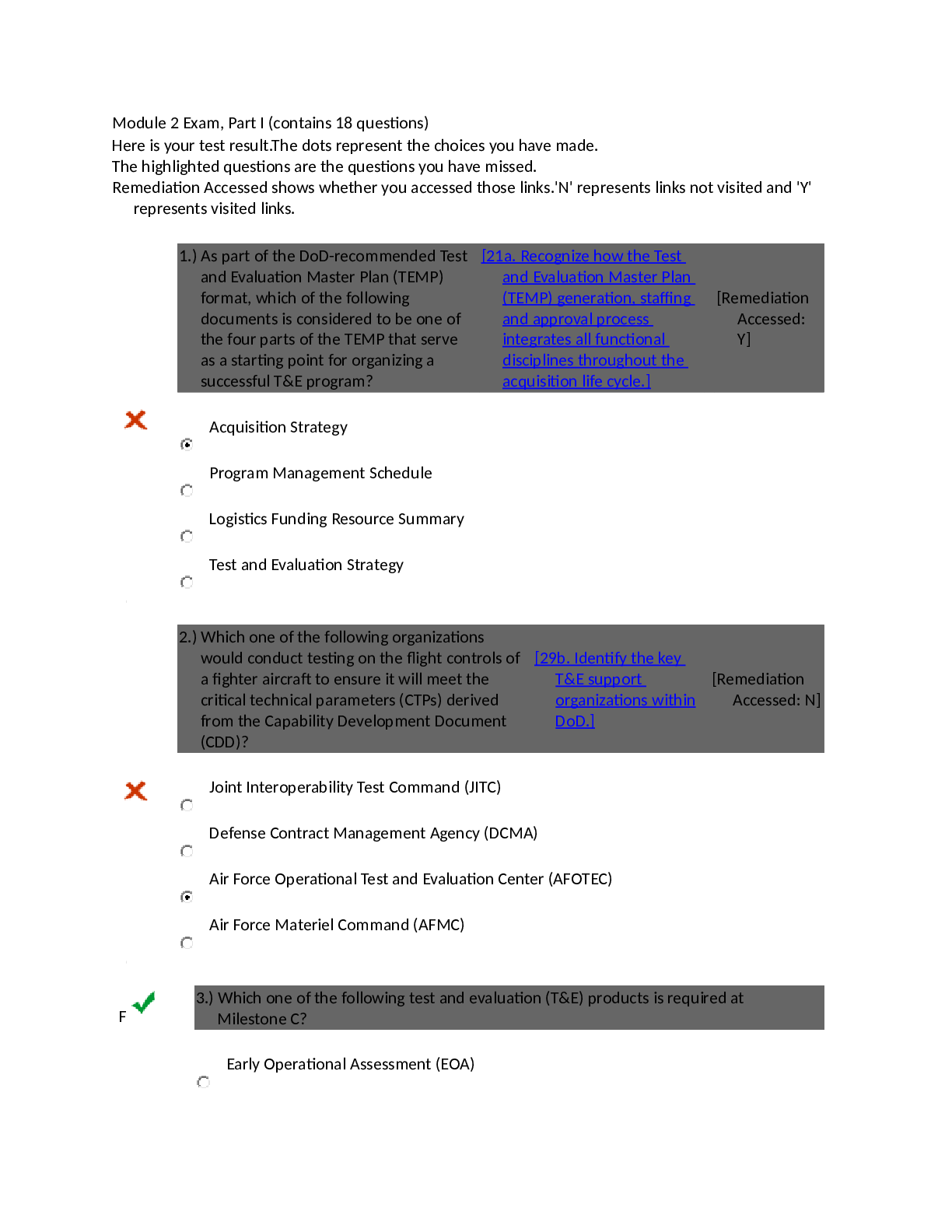
Reviews( 0 )
Document information
Connected school, study & course
About the document
Uploaded On
Mar 04, 2022
Number of pages
30
Written in
Additional information
This document has been written for:
Uploaded
Mar 04, 2022
Downloads
0
Views
180


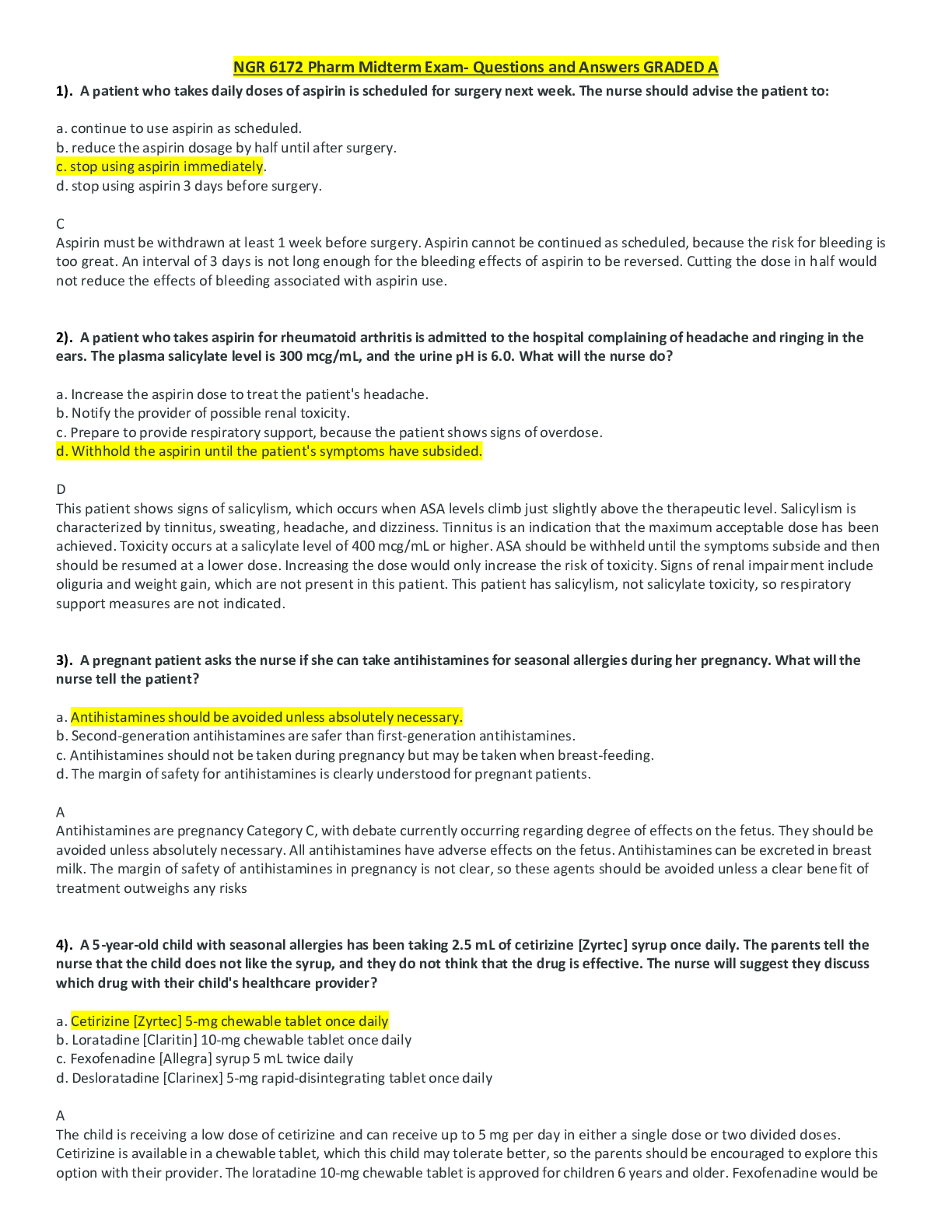

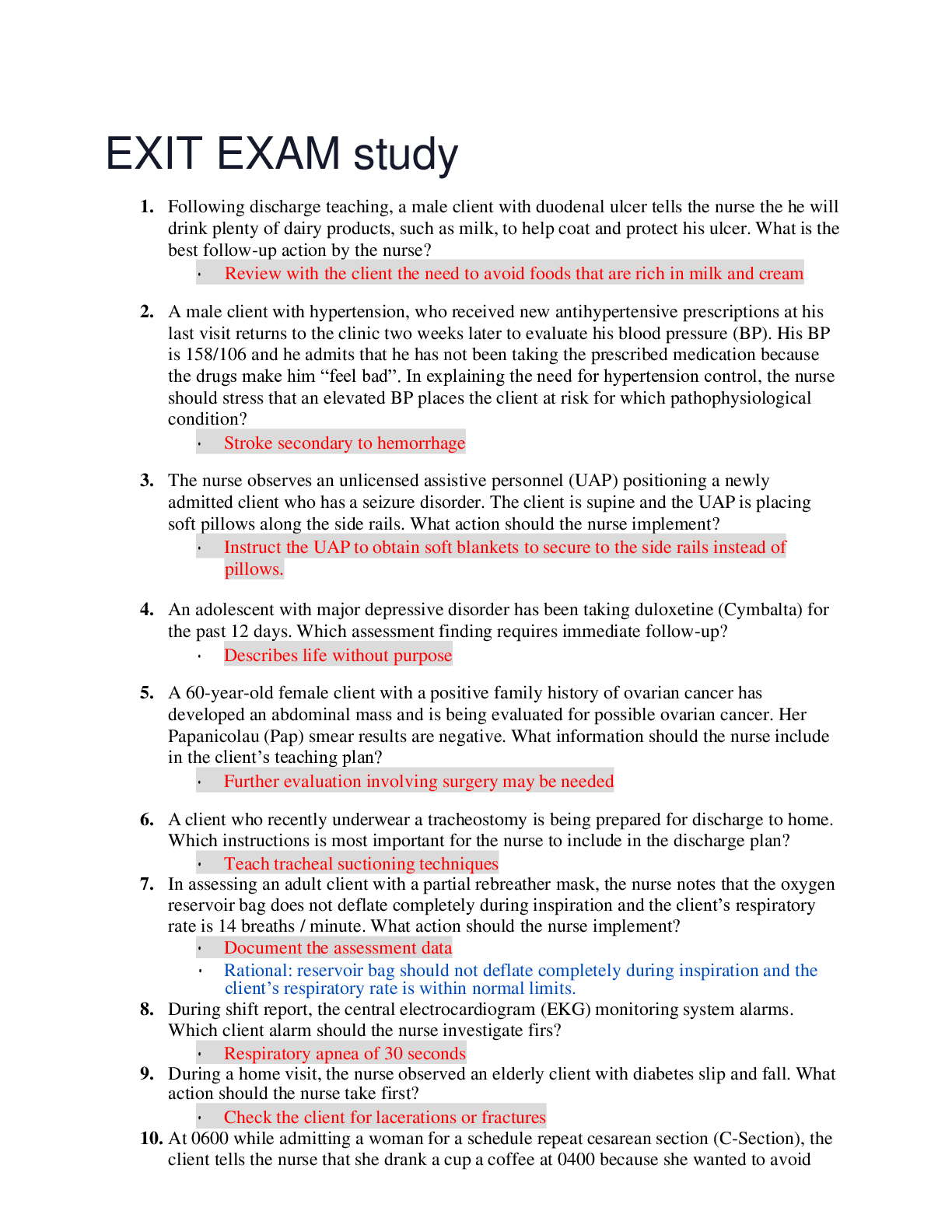
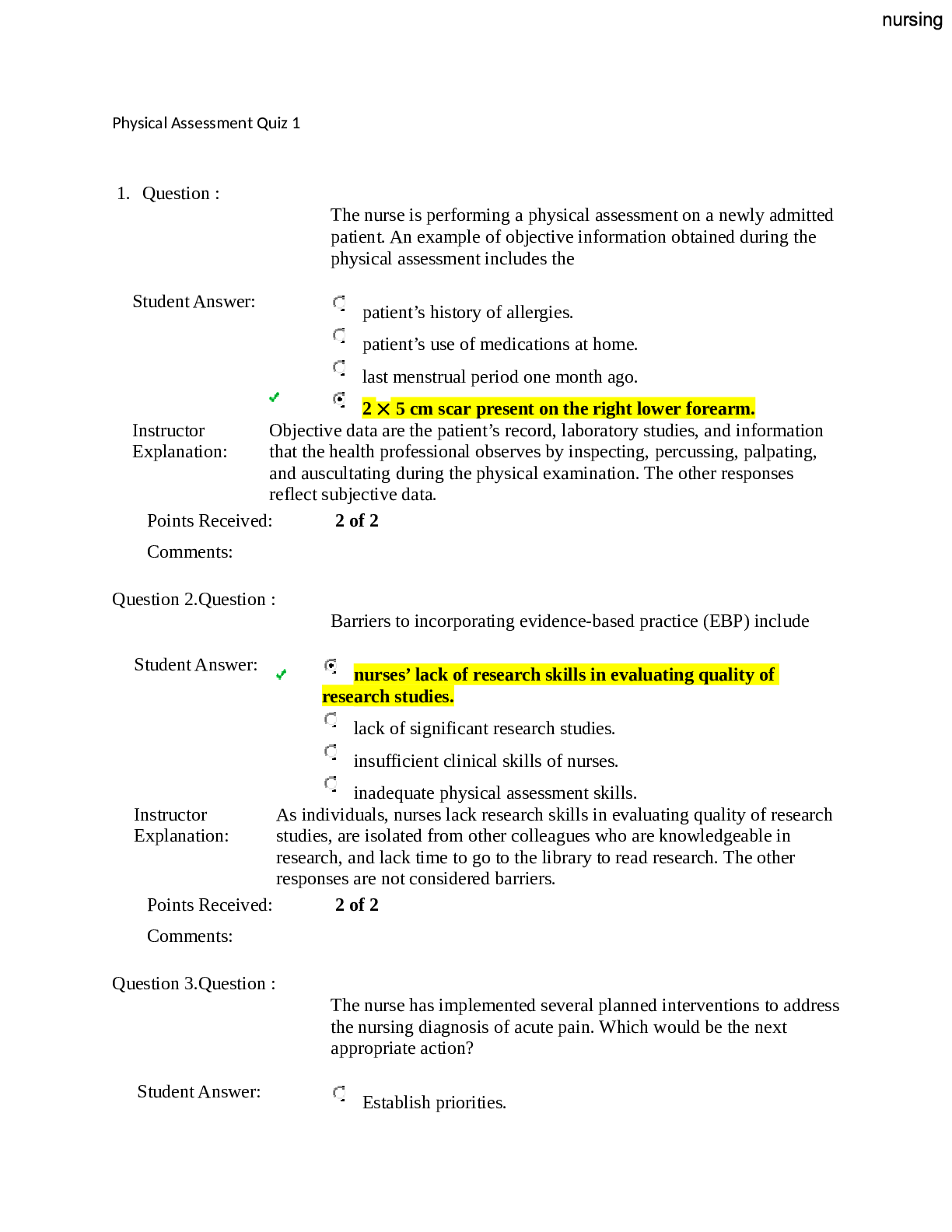
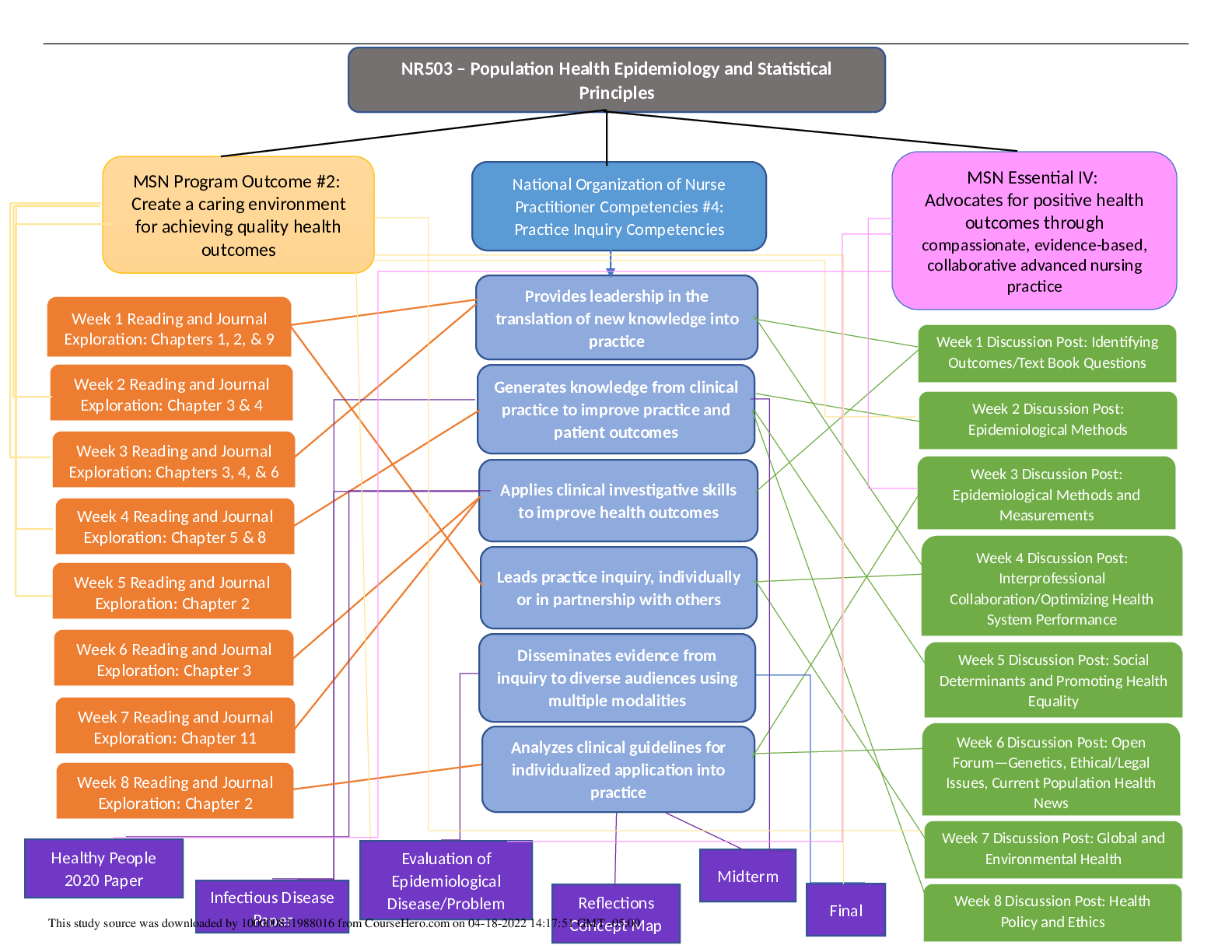

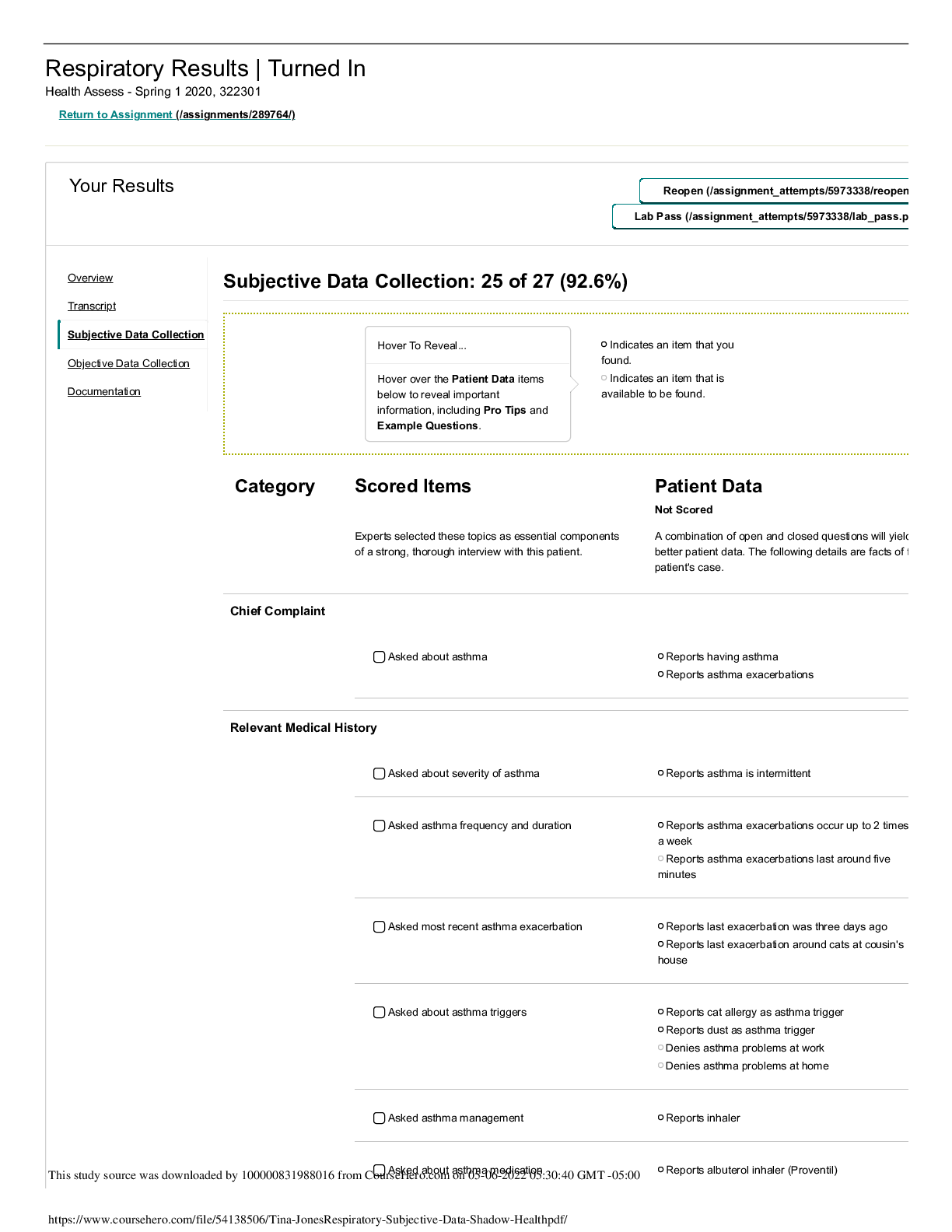
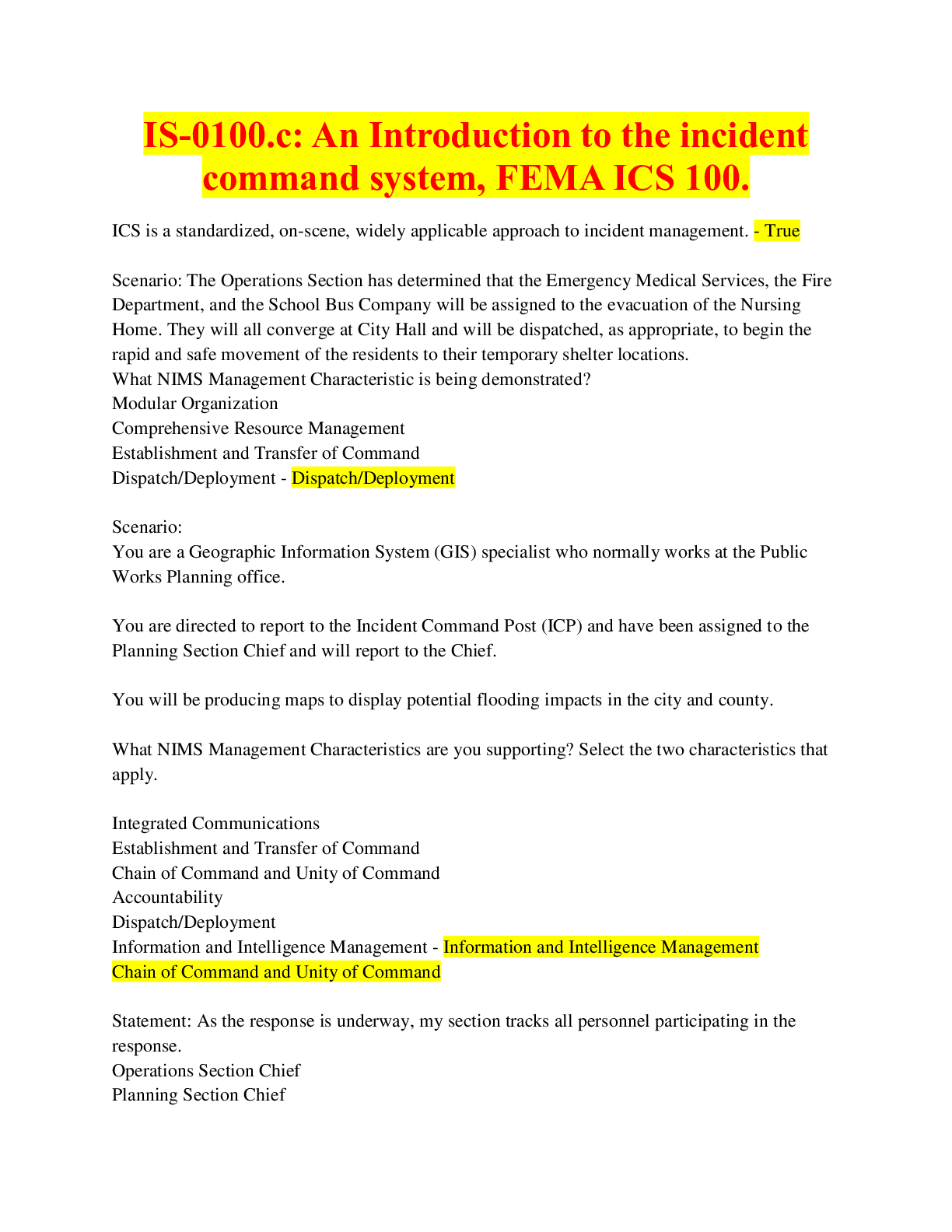

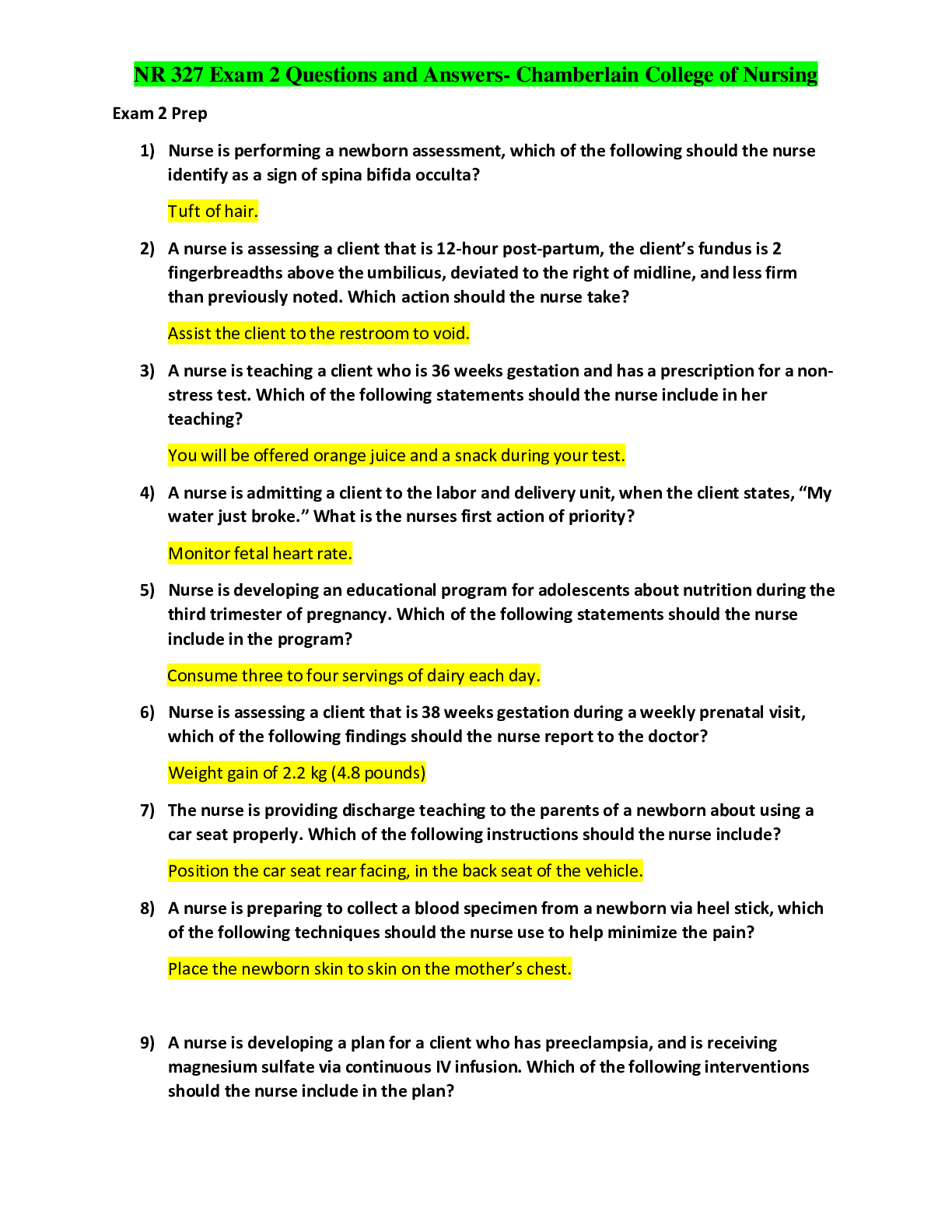

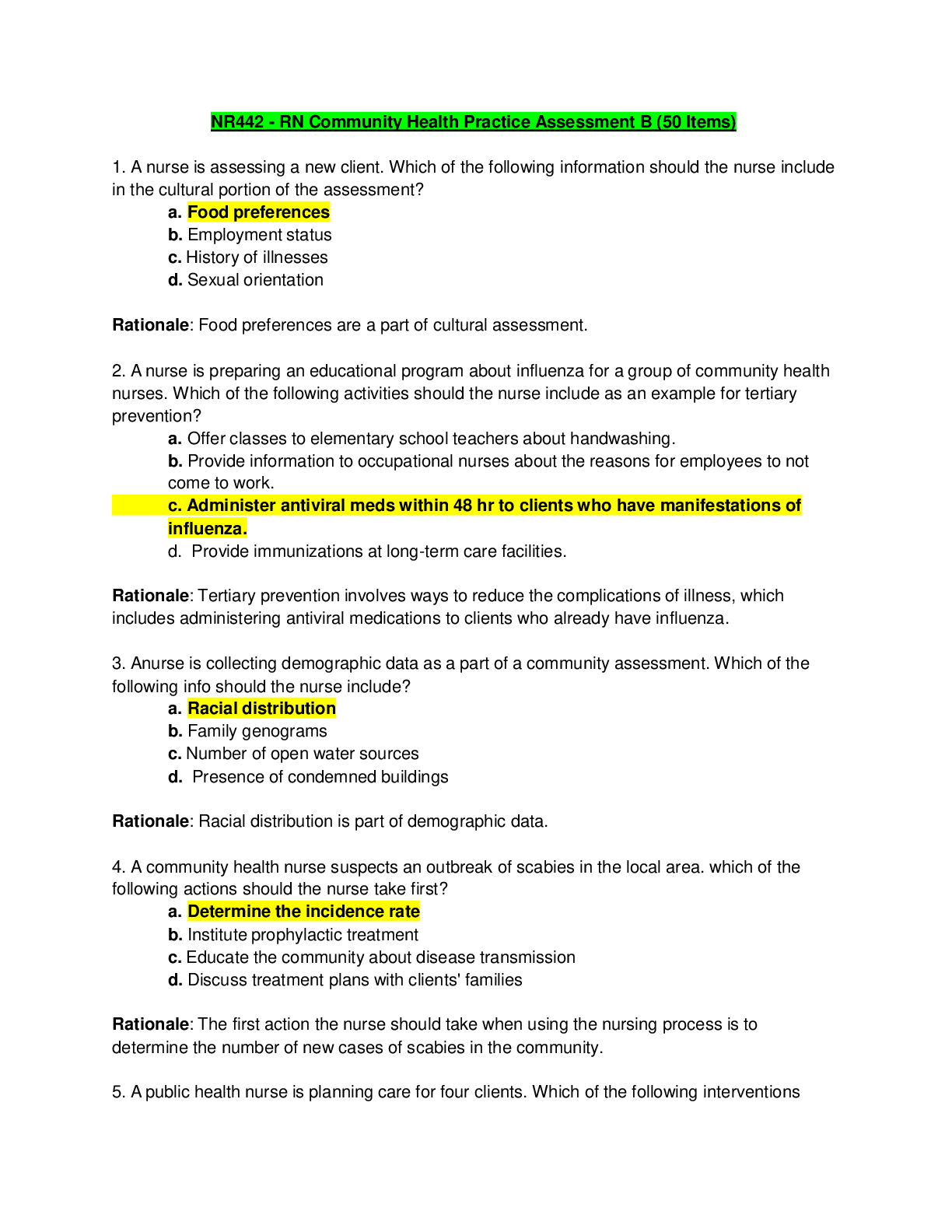
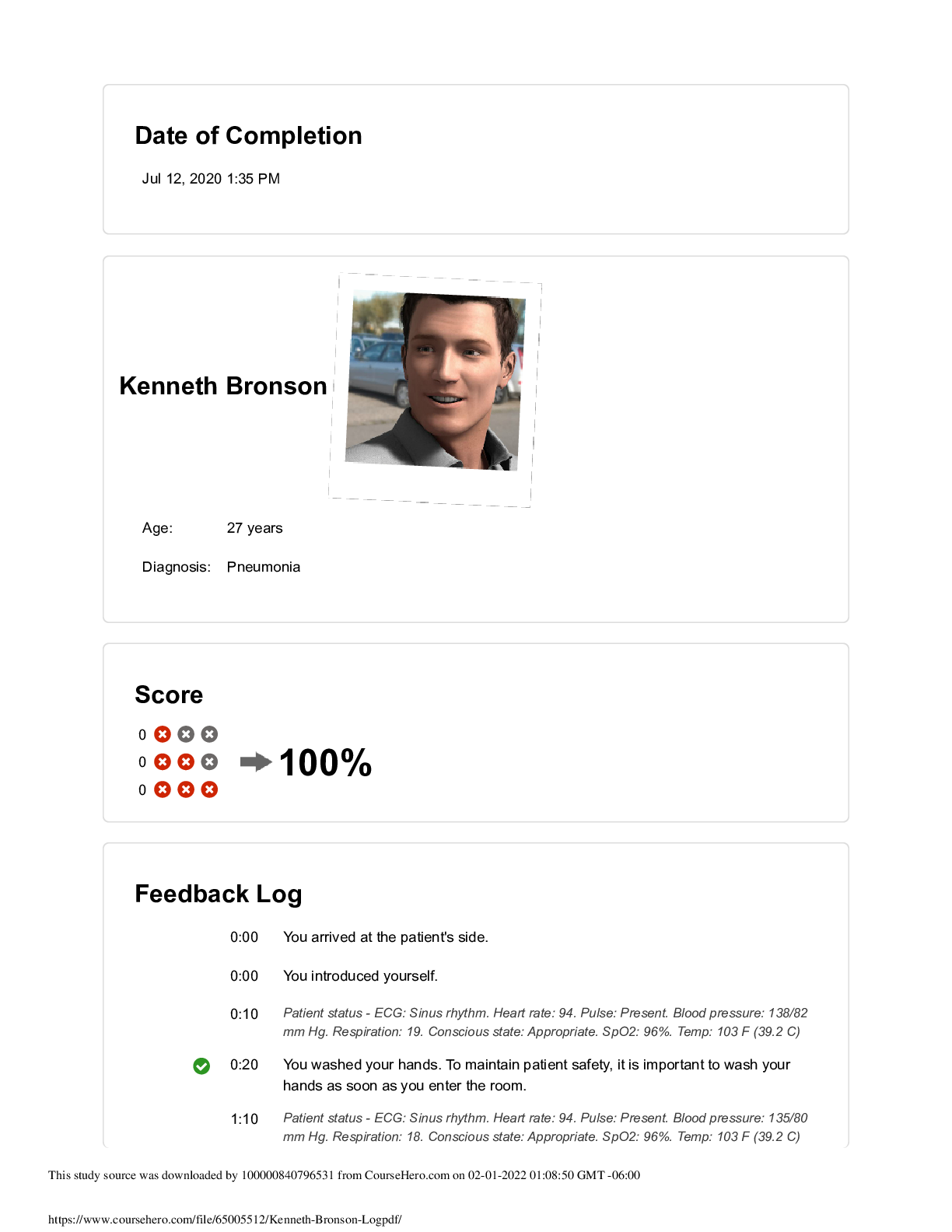

.png)
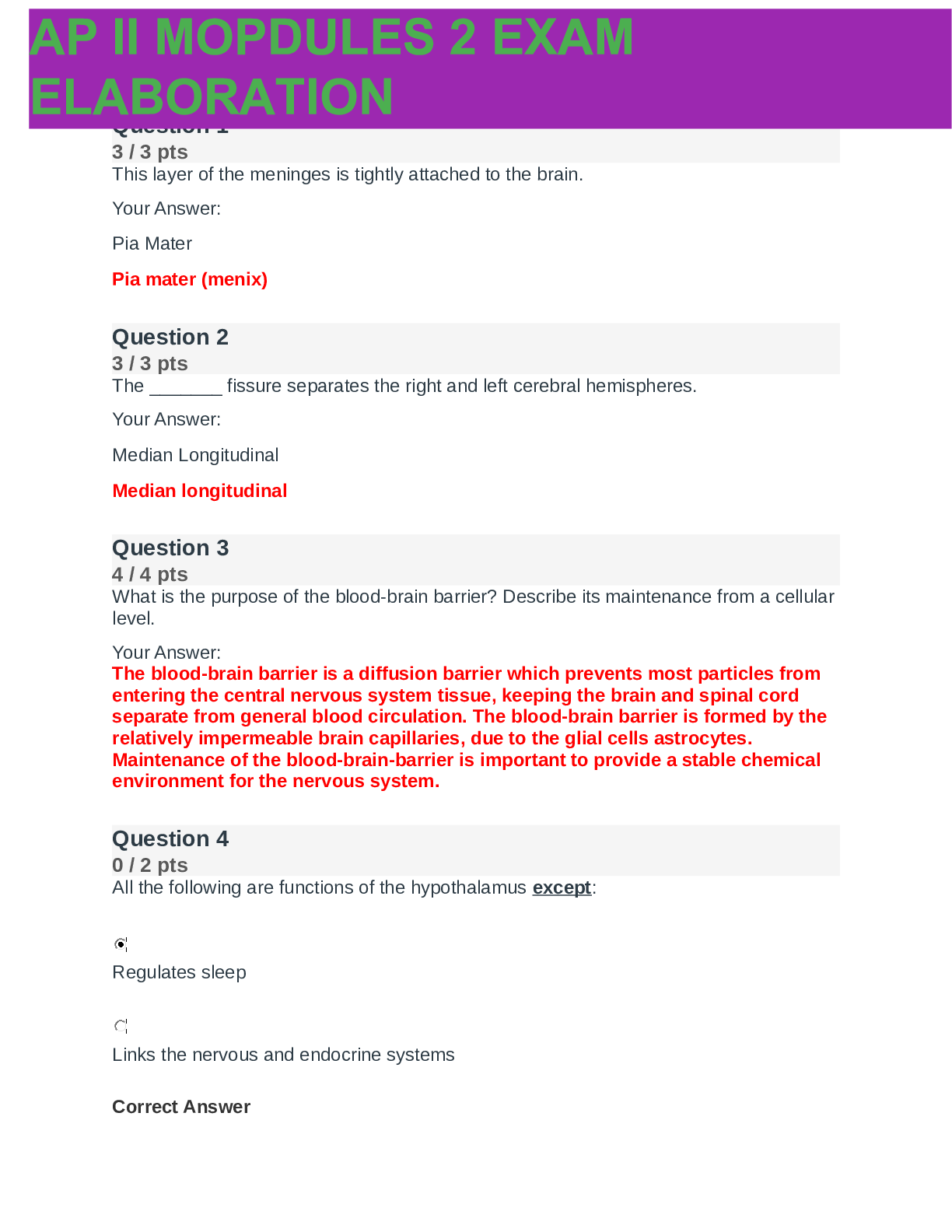

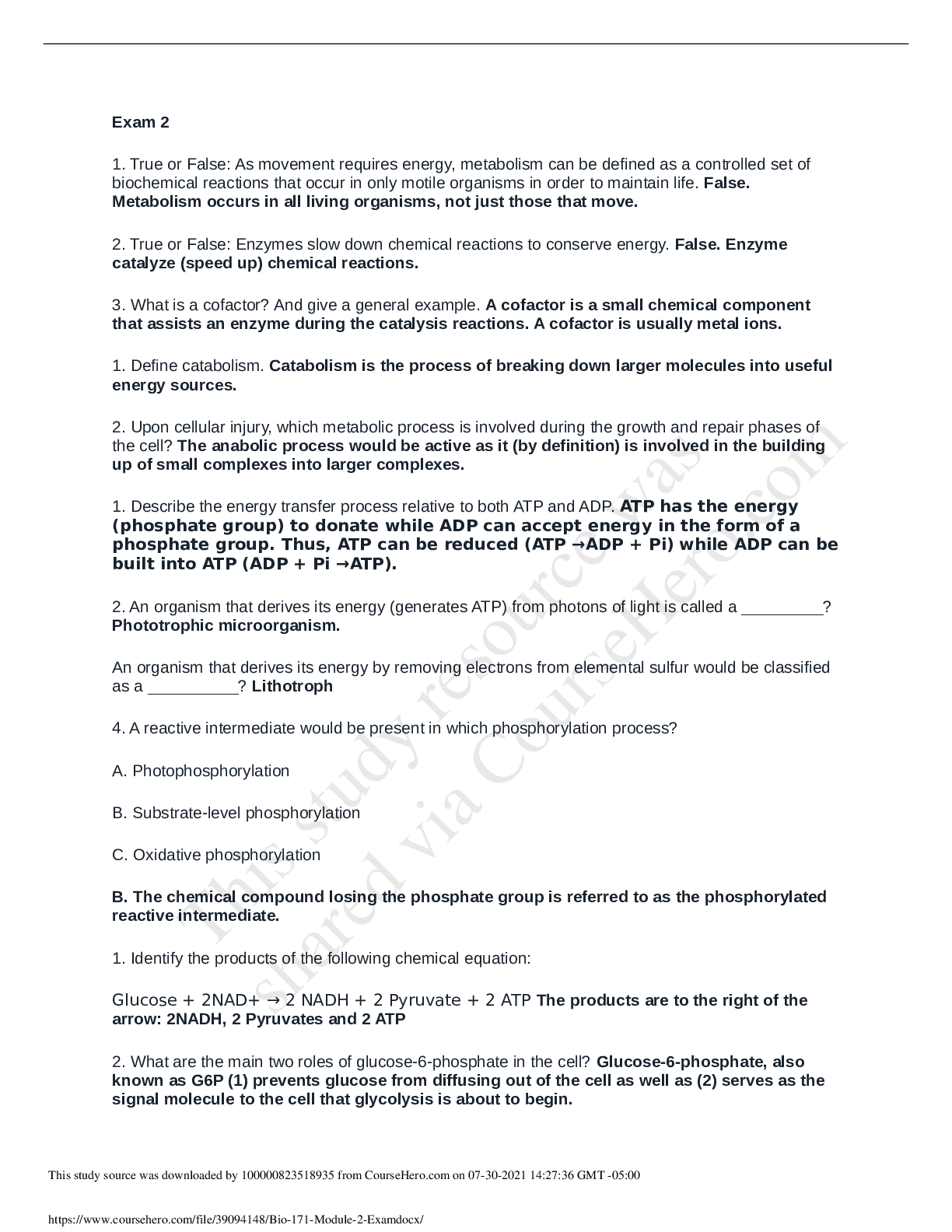
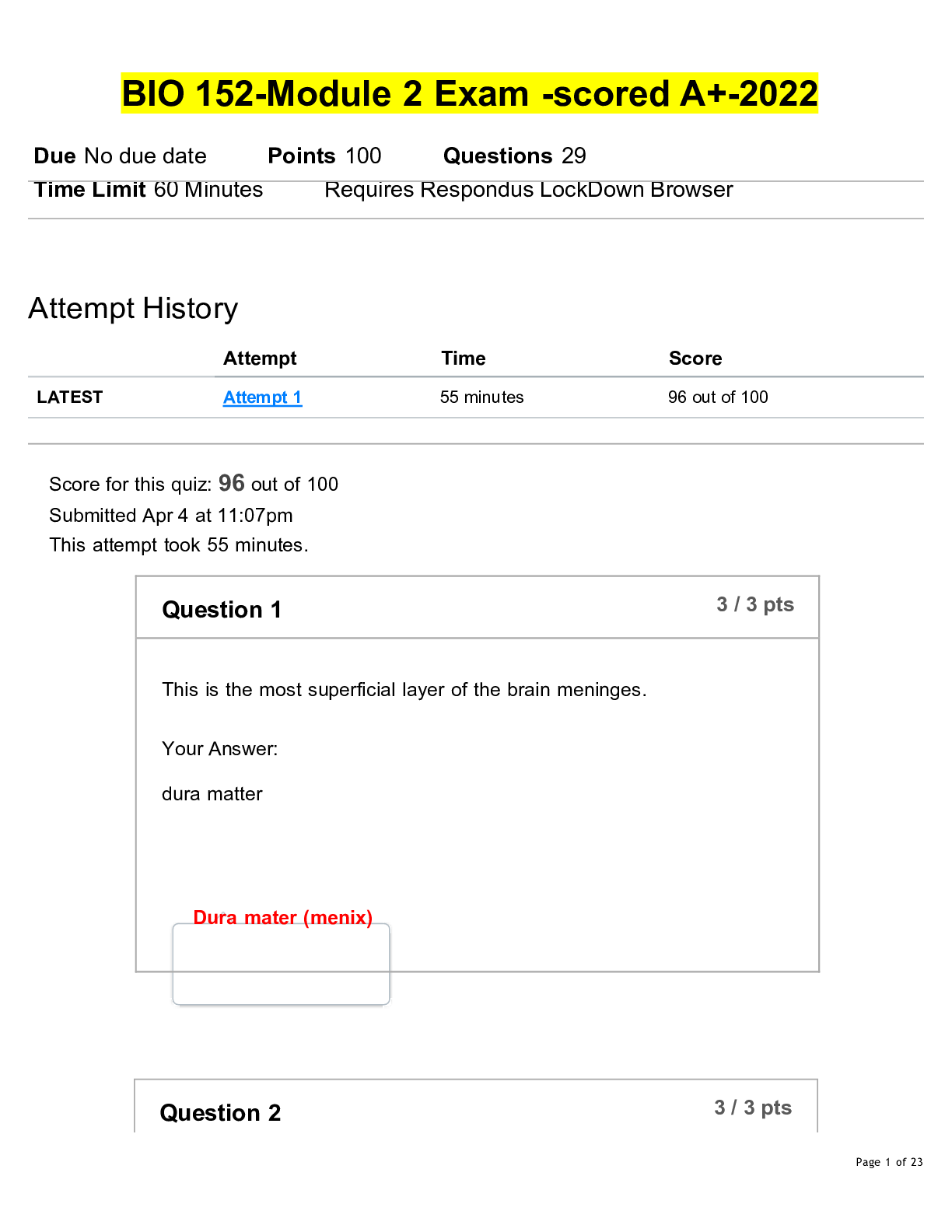
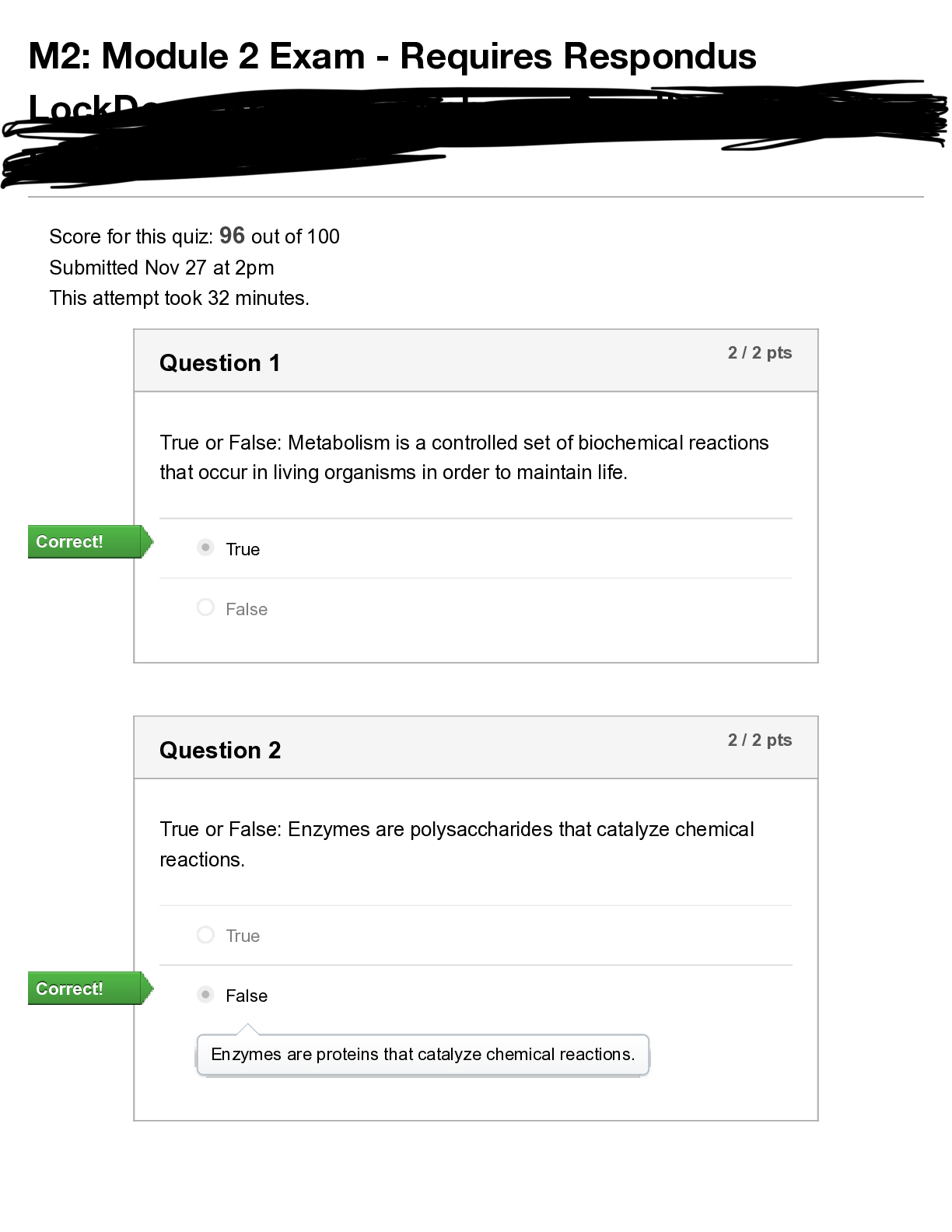
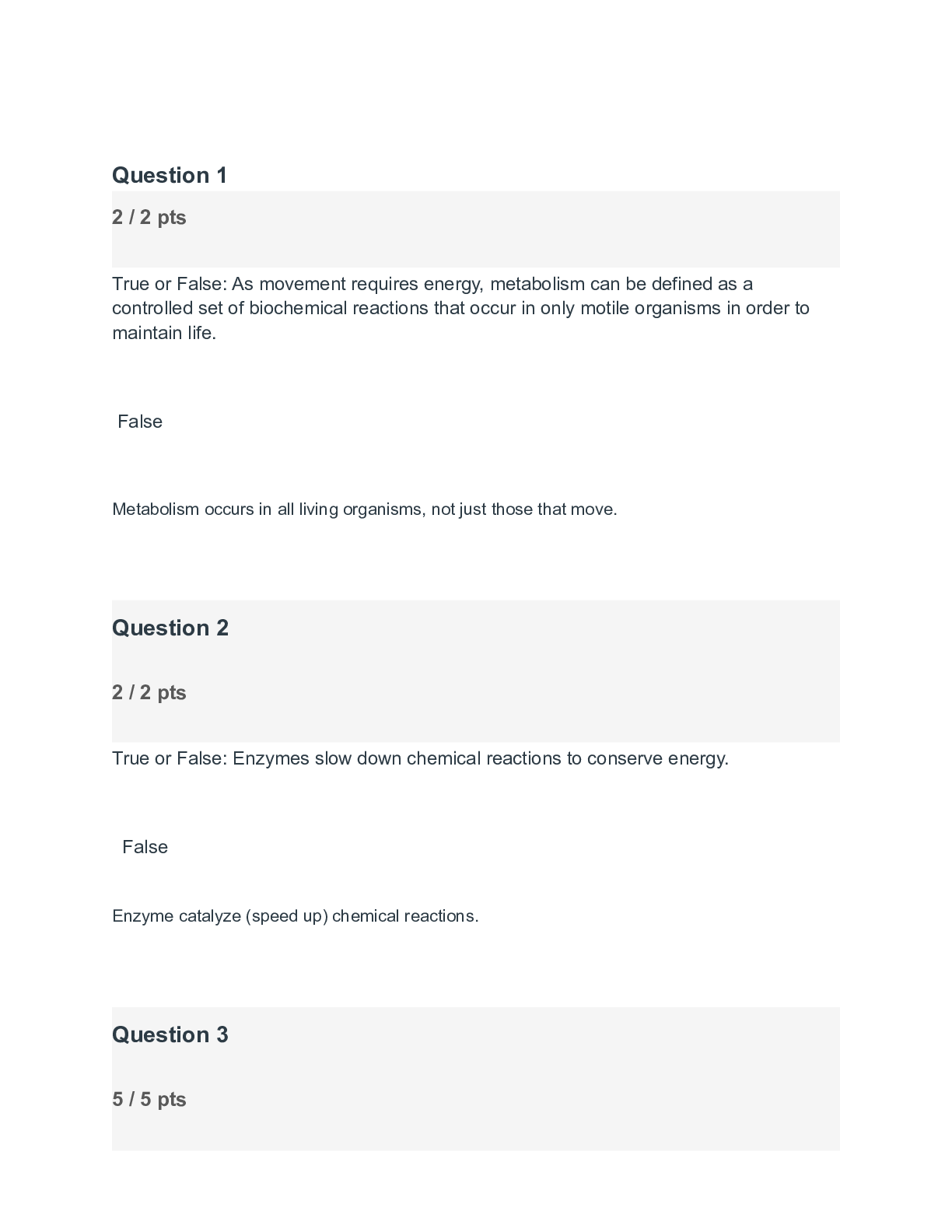

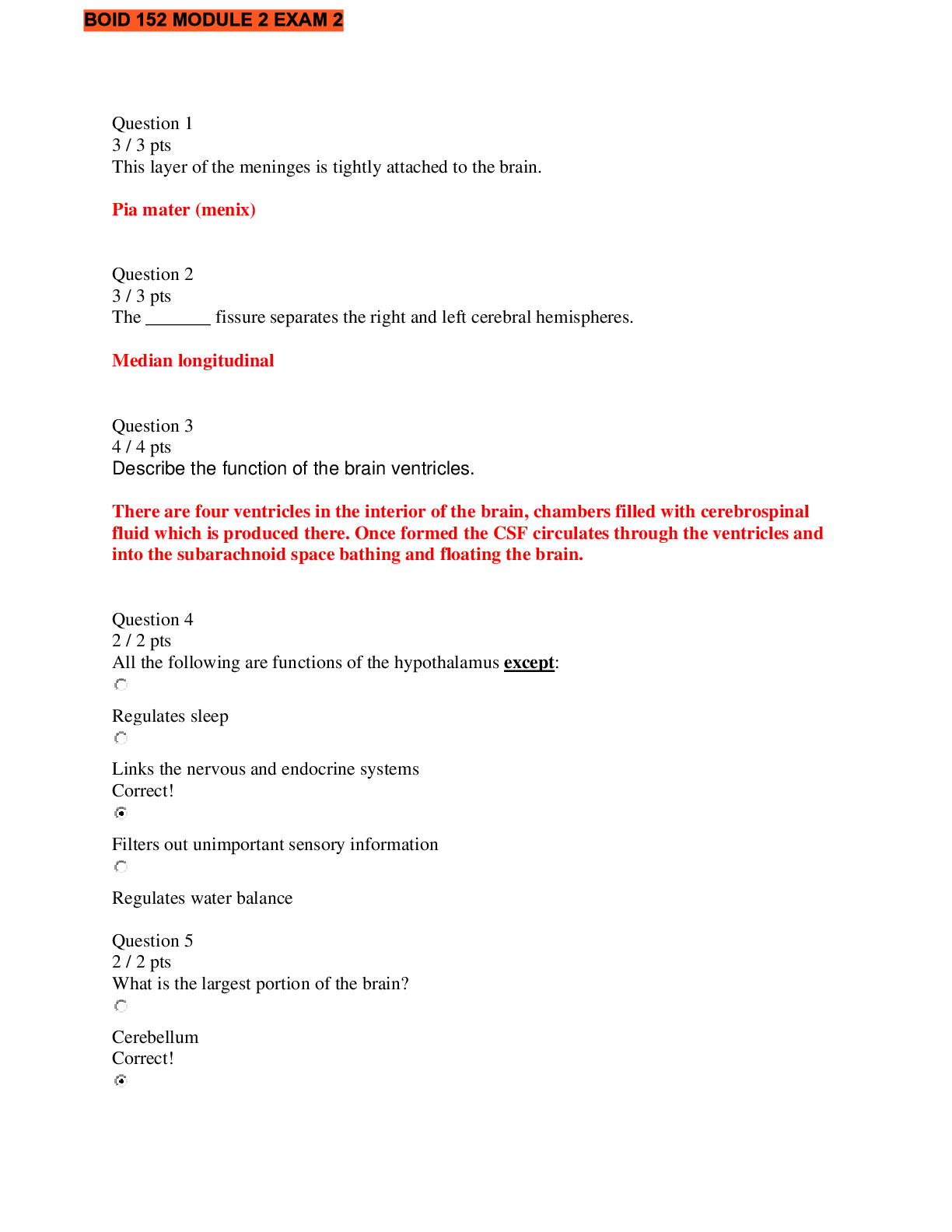

.png)
